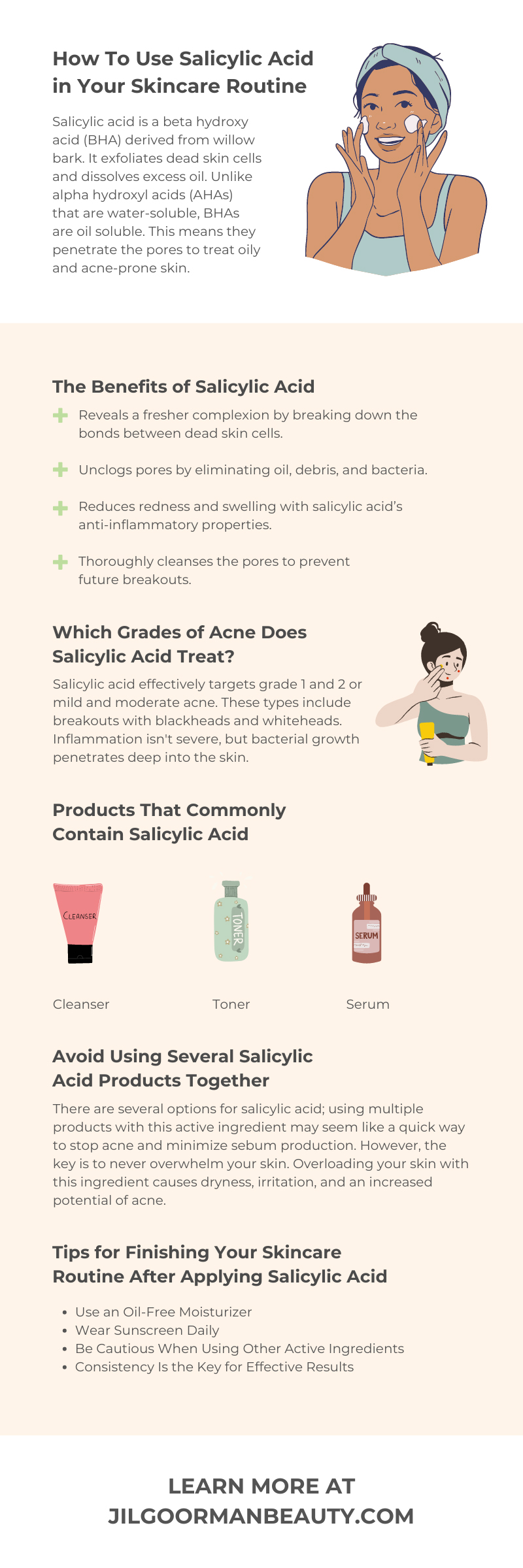Many individuals struggle with skin issues, such as inflammation, oiliness, and acne. Of these issue, acne can be especially difficult to deal with. One of the best solutions is the active ingredient salicylic acid. Learn the characteristics of salicylic acid and how to use it in your skincare routine.
What Is Salicylic Acid?
Salicylic acid is a beta hydroxy acid (BHA) derived from willow bark. It exfoliates dead skin cells and dissolves excess oil.
Unlike alpha hydroxyl acids (AHAs) that are water-soluble, BHAs are oil soluble. This means they penetrate the pores to treat oily and acne-prone skin.
The Benefits of Salicylic Acid
Before applying an active skincare ingredient, you first need to understand its qualities. Here’s a quick look at the benefits of using salicylic acid:
- Reveals a fresher complexion by breaking down the bonds between dead skin cells.
- Unclogs pores by eliminating oil, debris, and bacteria.
- Reduces redness and swelling with salicylic acid’s anti-inflammatory properties.
- Thoroughly cleanses the pores to prevent future breakouts.
Which Grades of Acne Does Salicylic Acid Treat?
Salicylic acid effectively targets grade 1 and 2 or mild and moderate acne. These types include breakouts with blackheads and whiteheads. Inflammation isn't severe, but bacterial growth penetrates deep into the skin.
The gentle exfoliating properties of salicylic acid help clear dead skin and excess oil without severe irritation. More severe cases, like grade 3 and 4 acne, generally feature deeper cysts and nodules. These conditions often require stronger treatments, such as prescription medications, chemical peels, or high concentrations of benzoyl peroxide. Salicylic acid’s formula offers lighter solutions that are ideal for mild and moderate grades.
What Are the Different Concentrations?
Salicylic acid ranges from 0.5 percent to 2 percent. Lower concentrations are suitable for those new to this ingredient or with sensitive skin. They provide mild exfoliation to unclog pores without causing irritation.
Higher concentrations, such as those around 2 percent, offer more potent effects. They can tackle stubborn acne and deeply cleanse oily skin. However, starting with a lower concentration can help your skin adjust. Once your skin builds tolerance, you can gradually increase the concentration for better results.
Products That Commonly Contain Salicylic Acid
Skincare for acne comes in many different forms. You can choose various products that include salicylic acid to clear up your complexion.
Cleanser
A cleanser is the foundation of clear skin. Many cleansers are formulated with active ingredients to thoroughly remove dirt, bacteria, dead skin cells, and sebum from the pores. With the addition of salicylic acid, you’re mitigating the likelihood of acne.
Use warm water to dampen the skin and massage the product to your face and neck for at least 60 seconds. Rinse your skin and pat dry with a dry, clean towel. Use a cleanser morning and night for the best results.
Toner
A toner with salicylic acid exfoliates and balances the skin. Saturate a cotton pad with the toner and sweep it across your face and neck. Be sure to avoid your eyes.
Do not rinse the toner; you want your skin to completely take in the product. Let it settle before moving onto the next step of your routine. Only use a salicylic acid toner once a day to prevent drying out the skin.
Serum
A salicylic acid serum delivers concentrated benefits to your skin. After cleansing and toning, apply a few drops of the serum to your face. Gently pat it into your skin, focusing on problem areas.
Allow the serum to absorb fully before applying moisturizer. Use the serum once or twice a week to avoid over-exfoliation.
Avoid Using Several Salicylic Acid Products Together
There are several options for salicylic acid; using multiple products with this active ingredient may seem like a quick way to stop acne and minimize sebum production. However, the key is to never overwhelm your skin. Overloading your skin with this ingredient causes dryness, irritation, and an increased potential of acne.
Tips for Finishing Your Skincare Routine After Applying Salicylic Acid
Incorporate a Hydrating Serum
Hyaluronic acid and niacinamide are two of the best nourishing serums for your skin. They lock in moisture, increase cell turnover, and calm redness for a bright complexion.
Use an Oil-Free Moisturizer
Moisturizers that contain oil are more likely to clog pores. Since you’re putting in the effort to minimize acne with salicylic acid, you need to follow-up with an oil-free moisturizer to maintain a balance.
Salicylic acid exfoliates the skin. A moisturizer replenishes hydration lost during exfoliation. This step will prevent compromising the skin barrier, overproduction of oil, and worsening breakouts. Your skin will feel smooth and hydrated by the end of your skincare routine.
Wear Sunscreen Daily
Even though salicylic acid isn't associated with increased sun sensitivity like other active ingredients, wearing sunscreen daily is an important step in your routine. Protecting your skin barrier from harmful UV rays helps maintain overall skin health and prevents premature aging.
While salicylic acid works to unclog pores and reduce acne, it does not shield your skin from the sun’s damaging effects. Daily sunscreen application creates an additional layer of protection to ensure your skin effectively combats oiliness and breakouts.
Be Cautious When Using Other Active Ingredients
When finishing your skincare routine, refrain from layering other strong active ingredients, such as retinoids or benzoyl peroxide. If you want to use those ingredients, use them at separate times of the day. This helps prevent irritation and supports your skin's recovery.
Consistency Is the Key for Effective Results
The secret to salicylic acid is to use one product at a time and apply it consistently. You’re more likely to see results when you apply it a minimum of once a day from a singular product.
In the initial weeks, you may experience a "purging" phase, where existing blemishes come to the surface, making your skin appear worse before it gets better. However, if you remain patient and stick to your routine, you should notice substantial progress within a few weeks.
Learning about how to use salicylic acid in your skincare routine is a step in the right direction. From differing skin types to the grades of acne people experience, Jil Goorman Beauty knows that treating acne is unique for everyone. Try the acne-starter kit for comprehensive treatment or begin with a singular product like the oily skin toner or exfoliating serum.
We understand that treating acne is a long process. Let Jil Goorman Beauty support you on your skincare journey with our acne-safe products!


